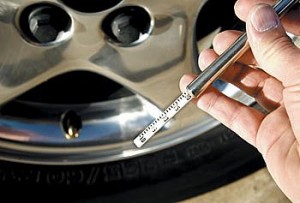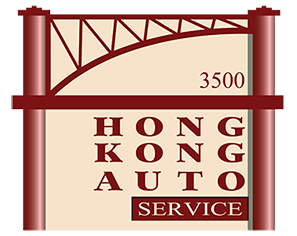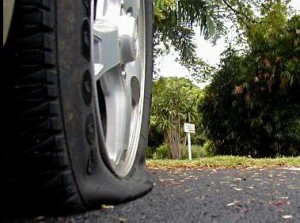‘Air’ time: How and why to check your tire pressure
If you discovered a simple tool that could save life, limb and money, would you learn how to use it? Meet the tire pressure gauge.
This little device—designed to help maintain proper tire inflation—can drastically improve gas mileage, increase tire lifespan, and keep you and loved ones safer on streets and highways.
In fact, properly filled tires can boost gas mileage by as much as 3.3 percent, according to the National Highway Traffic Safety Administration (NHTSA), which reports that underinflated tires might decrease mileage 0.3 percent for every psi deficiency in all four tires.

To obtain an accurate reading, evenly place the end of the tire-pressure gauge onto the valve stem and press firmly.
Think your tires are all properly inflated? Studies have indicated that nearly 30 percent of light vehicles regularly operate with at least one underinflated tire, according to NHTSA’s 2009 report, “Tire Pressure Maintenance – A Statistical Investigation.”
“Only a few psi difference from vehicle manufacturers’ recommended tire inflation pressure can affect a vehicle’s handling and stopping distance,” the report states. “Poor tire maintenance can increase incidences of blowouts and tread separations.”
Tire pressure is so critical that the government began requiring Tire Pressure Monitoring Systems (TPMS) in all 2008 model year and newer vehicles. While these systems can alert you when tire pressure drops 25 percent below the recommended range, they’re not foolproof.
Going the other way—overinflation—also presents problems. Pumping excess air into tires stiffens them and decreases the amount of tread that’s contacting the road. This reduces your safety, makes the vehicle ride more roughly, wears the tire unevenly and prematurely, and makes the tires more vulnerable to damage when striking potholes or other road hazards.
Maintaining proper inflation is, therefore, a balancing act and requires strict adherence to vehicle manufacturer’s recommendations, which typically are posted on the driver’s side door jamb. These numbers also might be found in the glove compartment and the owner’s manual. (Note: Don’t use the psi numbers on your tire sidewalls. These indicate the maximum pressure for the tires, not the recommended setting for the vehicle.)
As a general guideline, sedans usually require tires be inflated between 30 and 40 psi, while tires on larger vehicles need 45 psi. Note that some vehicles require more air in the front tires than the rear ones.
But first things first. You’ll need to have a tire pressure gauge. Digital versions are easily read and provide accurate readings, but less expensive traditional gauges work fine, too. It’s not a great idea to rely on a gas station’s air-machine gauge, but it can be useful in a pinch.
Pressure needs to be checked while tires are cold because they heat up during travel and will provide inflated readings while hot. Either check the pressure before driving or wait about 30 minutes for tires to cool after travel. However, some experts recommend waiting as much as three hours to obtain an accurate reading.
Remove the cap from the tire’s valve stem (the small cylindrical attachment that allows air into the tire). Evenly place the end of the tire pressure gauge onto the valve stem and press firmly. The pressure will prompt a readout on a digital gauge or push out the metered stick on a traditional gauge. (If the gauge is isn’t squarely seated on the valve, you may need to repeat this step a time or two to obtain an accurate reading.)
If psi readings for all four tires match the recommended numbers, it’s thumbs-up and your vehicle is road-worthy. However, if you discover the tires are above or below proper pressure, you’ll need to adjust them. If you don’t own an air compressor, you’ll need to travel to a service station and use their air hose. If possible, avoid driving more than a mile so tires don’t heat up.
For underinflated tires, place the air-hose nozzle onto the stem. Some hoses will insert air once they’re positioned on the stem while others require a handle be squeezed to release air.  A hissing sound means air is escaping; simply secure the nozzle with more force to secure the connection. Frequently check tire pressure to prevent overinflation. As you approach the correct reading, user shorter air bursts until the tire is properly inflated.
A hissing sound means air is escaping; simply secure the nozzle with more force to secure the connection. Frequently check tire pressure to prevent overinflation. As you approach the correct reading, user shorter air bursts until the tire is properly inflated.
Overinflated tires can be brought into line by loosely placing the gauge on the stem and allowing air to escape.
Once tires are at the proper pressure, screw on the valve stem caps, being careful not to damage them by over tightening. Caps prevent the stems from becoming soiled and damaged.
Changing weather conditions and temperature fluctuations can impact tire pressure significantly. In fact, every 10-degree decrease prompts a 1 psi dip.
Therefore, check tire pressure monthly. One more thing: Don’t rely on your eyes to “gauge” whether a tire is OK. Only severely deflated tires exhibit obvious visual signs that they’ve lost air.

